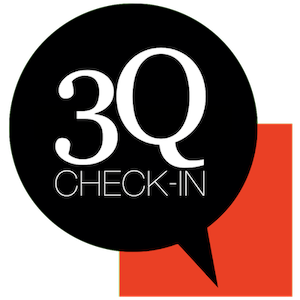
WHY 3Q CHECK-INS
When was the last time your boss checked in with you? For most people, the answer is never … unless we throw fairy dust at an annual review and call it a check-in.
This is not because bosses don’t want to develop and support the people who report to them. Most bosses just aren’t very good at it. For a lot of leaders and managers, consistent, substantive check-ins are a soft skill that's very hard.
The Three Questions, if you know how to ask them, are easy:
1. How are you?
2. How are we?
3. How can I help?
3Q CHECK-INS ARE AN EASY-TO-LEARN/EASY-TO-MAINTAIN SUPPORT STRUCTURE FOR PEOPLE YOU WANT TO DEVELOP AND PEOPLE YOU DON’T WANT TO LOSE
There is zero magic in 3Q Check-ins — none, zilch, absolutamenté nada — we know exactly why it works.
It works because, if you’ve met the basic demands of a livable wage — and maybe even if you haven’t — the most valuable thing you have to offer as a leader is your attention. And 3Q is a refined attention distribution system.
3Q Check-ins are simple, direct, reliable, on-the-level conversations focused on the mission of the organization and the productivity and wellbeing of individuals and their teams. No smoke, no mirrors, no secret handshakes. Everyone can see exactly what’s going on.
Consistent
Monthly 3Q appointments establish a structured space for leaders to hear from the employees and volunteers who report directly to them.
Everyone has the chance to be heard every month.
Engaging
As people gain confidence in 3Questions Check-ins — which is to say, as people learn they can trust each other with real information — transparency, initiative, and followthrough increase …
which strengthens alignment …
which elevates productivity …
which boosts morale.
Clarifying
Including 3Q check-ins in the onboarding of new employees and volunteers routinely cements — in the first 90 days — a productive connection with supervisors — or reveals the underlying characteristics of a weak fit.
Similarly, unless there are preexisting tensions, introducing 3Q Check-ins with experienced staff is typically welcomed as positive attention — or brings hidden fractures to light.
3Q Check-ins helps supervisors pinpoint domains for employee development — or makes it plain that someone has been mismatched to a role.
Revealing
3Q is organizational radar. You can spot problems as blips on the horizon before they become bombs in your office.
3Q helps you spot new talent too; tapping your whole employee network instead of relying on your inner circle to identify rising stars in your organization.
If you could accomplish all that in 15 minutes a month per direct report… why wouldn’t you?
Oh, and the Three Questions are:
The three questions are easy:
1. How are you doing?
2. How are we doing?
3. How can I help?
So you’ll know, I was honored to read an early draft of this work. I was impressed then. I’m even more impressed now with this final product. It’s a quick read that might fool you into thinking it’s too simple to be effective. That’s a mistake. It’s simple like a sharp knife…and like a sharp knife, you’ll wanna know how to use it effectively. If you own a business (as I do) or if you run an organization or have people who report to you, it’s worth getting this book and discovering how 3Q works. Buy. This. Book. Do. What. They. Say. It’ll be awesome.
Steven Thomas . CEO & Founding Partner at Oneicity . Seattle WA

